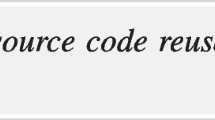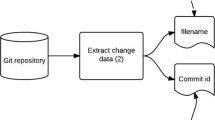Abstract
When interacting with source control management system, developers often commit unrelated or loosely related code changes in a single transaction. When analyzing version histories, such tangled changes will make all changes to all modules appear related, possibly compromising the resulting analyses through noise and bias. In an investigation of five open-source Java projects, we found between 7 % and 20 % of all bug fixes to consist of multiple tangled changes. Using a multi-predictor approach to untangle changes, we show that on average at least 16.6 % of all source files are incorrectly associated with bug reports. These incorrect bug file associations seem to not significantly impact models classifying source files to have at least one bug or no bugs. But our experiments show that untangling tangled code changes can result in more accurate regression bug prediction models when compared to models trained and tested on tangled bug datasets—in our experiments, the statistically significant accuracy improvements lies between 5 % and 200 %. We recommend better change organization to limit the impact of tangled changes.










Similar content being viewed by others
Notes
Since it is undecidable whether a program will ever terminate under arbitrary conditions, we are, in general, also unable to decide whether two code changes may influence each other during a possible infinite program run.
This ConfVoters is slightly penalized by the artificial blob generation strategy pack creating blobs by combining changes to files based on directory distance (see Subsection 4.2). However, we favored a more realistic distribution of changes over total fairness across all ConfVoters.
Since we are analyzing artificially tangled change sets only, the file mapping error rate without untangling lies at 100 %. Having a error rate after untangling of 19 %, the result is a reduction rate of 100 %−19 %=81 %.
References
Alam O, Adams B, Hassan AE (2009) Measuring the progress of projects using the time dependence of code changes. In: ICSM, pp 329–338
Anvik J, Hiew L, Murphy GC (2006) Who should fix this bug? In: Proceedings of the 28th international conference on Software engineering. ACM, pp 361–370
Bachmann A, Bird C, Rahman F, Devanbu P, Bernstein A (2010) The missing links: bugs and bug-fix commits. In: Proceedings of the eighteenth ACM SIGSOFT international symposium on Foundations of software engineering. ACM, pp 97–106
Bhattacharya P (2011) Using software evolution history to facilitate development and maintenance. In: Proceeding of the 33rd international conference on Software engineering. ACM, pp 1122– 1123
Bird C, Bachmann A, Aune E, Duffy J, Bernstein A, Filkov V, Devanbu P (2009) Fair and balanced? Bias in bug-fix datasets. In: Proceedings of the the 7th joint meeting of the European software engineering conference and the ACM SIGSOFT symposium on The foundations of software engineering, ESEC/FSE ’09. ACM, pp 121–130
Bird C, Nagappan N, Gall H, Murphy B, Devanbu P (2009) Putting it all together: Using socio-technical networks to predict failures. In: Proceedings of the 2009 20th International Symposium on Software Reliability Engineering, ISSRE ’09. IEEE Computer Society, Washington, pp 109–119. doi:10.1109/ISSRE.2009.17
Bonacich P (1987) Power and centrality: a family of measures. American journal of sociology
Csardi G, Nepusz T (2006) The igraph software package for complex network research. InterJournal Complex Systems:1695. http://igraph.sf.net
Dagenais B, Hendren L (2008) Enabling static analysis for partial Java programs. In: Proceedings of the 23rd ACM SIGPLAN conference on Object-oriented programming systems languages and applications, OOPSLA ’08. ACM, pp 313–328
Dallmeier V (2010) Mining and checking object behavior. Ph.D. thesis, Universität des Saarlandes
Herzig K (2012) Mining and untangling change genealogies. Ph.D. thesis, Universität des Saarlandes
Herzig K., Just S., Rau A., Zeller A. (2013) Predicting defects using change genealogies. In: Proceedings of the 2013 IEEE 24nd international symposium on software reliability engineering, ISSRE ’13. IEEE Computer Society
Herzig K, Just S, Zeller A (2013) It’s not a bug, it’s a feature: how misclassification impacts bug prediction. In: Proceedings of the 2013 international conference on software engineering, ICSE ’13. IEEE Press, Piscataway, pp 392–401
Herzig K., Zeller A. (2013) The Impact of Tangled Code Changes. IEEE Press, Piscataway, pp 121–130
Hindle A, German D, Godfrey M, Holt R (2009) Automatic classication of large changes into maintenance categories. In: Program comprehension, 2009. ICPC ’09. 17th International Conference on IEEE, pp. 30–39
Hindle A, German DM, Holt R (2008) What do large commits tell us? A taxonomical study of large commits. In: Proceedings of the 2008 international working conference on Mining software repositories, MSR ’08. ACM, pp 99–108
Jaccard P (1901) Étude comparative de la distribution florale dans une portion des Alpes et des Jura. Bulletin del la Société Vaudoise des Sciences Naturelles 37:547–579
Karypis G, Kumar V (1995) Analysis of multilevel graph partitioning. In: Proceedings of the 1995 ACM/IEEE conference on Supercomputing, Supercomputing 1995. ACM
Karypis G, Kumar V (1995) MeTis: unstructured graph partitioning and sparse matrix ordering system. Version 2:0. URL http://citeseerx.ist.psu.edu/viewdoc/summary?doi=10.1.1.38.376
Karypis G, Kumar V (1998) A fast and high quality multilevel scheme for partitioning irregular graphs. SIAM J Sci Comput 20:359–392
Kawrykow D. (2011) Enabling precise interpretations of software change data. Master’s thesis, McGill University
Kawrykow D, Robillard MP (2011) Non-essential changes in version histories. In: Proceeding of the 33rd international conference on Software engineering, ICSE ’11. ACM, pp 351–360
Kim S, Whitehead Jr. EJ, Zhang Y (2008) Classifying software changes: Clean or buggy. IEEE Trans Softw Eng 34:181–196
Kim S, Zhang H, Wu R, Gong L (2011) Dealing with noise in defect prediction. In: Proceeding of the 33rd international conference on Software engineering, ICSE ’11. ACM, pp 481–490
Kim S, Zimmermann T, Whitehead Jr. EJ, Zeller A (2007) Predicting faults from cached history. In: Proceedings of the 29th International Conference on Software Engineering, ICSE ’07. IEEE Computer Society, Washington, pp 489–498. doi:10.1109/ICSE.2007.66
Kuhn M (2011) caret: classification and regression training. R package version 4.76. http://cran.r-project.org/web/packages/caret/caret.pdf
Li PL, Kivett R, Zhan Z, Jeon SE, Nagappan N, Murphy B, Ko AJ (2011) Characterizing the differences between pre- and post-release versions of software. In: Proceeding of the 33rd international conference on Software engineering. ACM, pp 716–725
Menzies T, Milton Z, Turhan B, Cukic B, Jiang Y, Bener A (2010) Defect prediction from static code features: current results, limitations, new approaches. Automated Software Engg 17:375–407
Mockus A, Votta LG (2000) Identifying reasons for software changes using historic databases. In: Proceedings of the international conference on software maintenance (ICSM’00), ICSM ’00. IEEE Computer Society, pp 120–130
Murphy-Hill E, Black A (2008) Refactoring tools: fitness for purpose. IEEE Software 25(5):38–44
Murphy-Hill E, Parnin C, Black AP (2009) How we refactor, and how we know it. Int Conf Softw Eng 287–297
Nagappan N, Murphy B, Basili V (2008) The influence of organizational structure on software quality: an empirical case study. In: Proceedings of the 30th international conference on Software engineering, ICSE ’08. ACM, New York, pp 521–530. doi:10.1145/1368088.1368160
Nguyen TH, Adams B, Hassan AE (2010) A case study of bias in bug-fix datasets. In: 2010 17th Working Conference on Reverse Engineering. IEEE Computer Society, pp 259–268
Premraj R, Herzig K (2011) Network versus code metrics to predict defects: a replication study. In: Proceedings of the 2011 international symposium on empirical software engineering and measurement, ESEM ’11. IEEE Computer Society, Washington, pp 215–224. doi:10.1109/ESEM.2011.30
R Development Core Team (2010) R: a language and environment for statistical computing. R Foundation for Statistical Computing
Robbes R, Lanza M, Lungu M (2007) An approach to software evolution based on semantic change. In: Fundamental approaches to software engineering, Lecture notes in computer science, vol 4422. Springer, Berlin, pp 27–41
Stoerzer M, Ryder BG, Ren X, Tip F (2006) Finding failure-inducing changes in java programs using change classification. In: Proceedings of the 14th ACM SIGSOFT international symposium on Foundations of software engineering. ACM, pp 57–68
Tosun A, Turhan B, Bener A (2009) Validation of network measures as indicators of defective modules in software systems. In: Proceedings of the 5th international conference on predictor models in software engineering, PROMISE ’09. ACM, New York, pp 5:1–5:9. doi:10.1145/1540438.1540446
Williams BJ, Carver JC (2010) Characterizing software architecture changes: a systematic review. Information and Software Technology 52(1):1–51
Witten IH, Frank E (2002) Data mining: practical machine learning tools and techniques with java implementations. SIGMOD Rec 31(1):76–77. doi:10.1145/507338.507355
Wloka J, Ryder B, Tip F, Ren X (2009) Safe-commit analysis to facilitate team software development. In: Proceedings of the 31st International Conference on Software Engineering, ICSE ’09. IEEE Computer Society, pp 507–517
Zimmermann T, Nagappan N (2008) Predicting defects using network analysis on dependency graphs. In: Proceedings of the 30th international conference on Software engineering, ICSE ’08. ACM, New York, pp 531–540. doi:10.1145/1368088.1368161
Zimmermann T, Premraj R, Zeller A (2007) Predicting defects for eclipse. In: Proceedings of the third international workshop on predictor models in software engineering, PROMISE ’07. IEEE Computer Society
Zimmermann T, Weigerber P, Diehl S, Zeller A (2004) Mining version histories to guide software changes. In: Proceedings of the 26th international conference on software engineering. IEEE Computer Society, pp 563–572
Acknowledgments
Jeremias Rößler and Nadja Altabari provided constructive feedback on earlier versions of this work. We thank the reviewers for their constructive comments.
Author information
Authors and Affiliations
Corresponding author
Additional information
Communicated by: Massimiliano Di Penta and Sung Kim
Rights and permissions
About this article
Cite this article
Herzig, K., Just, S. & Zeller, A. The impact of tangled code changes on defect prediction models. Empir Software Eng 21, 303–336 (2016). https://doi.org/10.1007/s10664-015-9376-6
Published:
Issue Date:
DOI: https://doi.org/10.1007/s10664-015-9376-6




